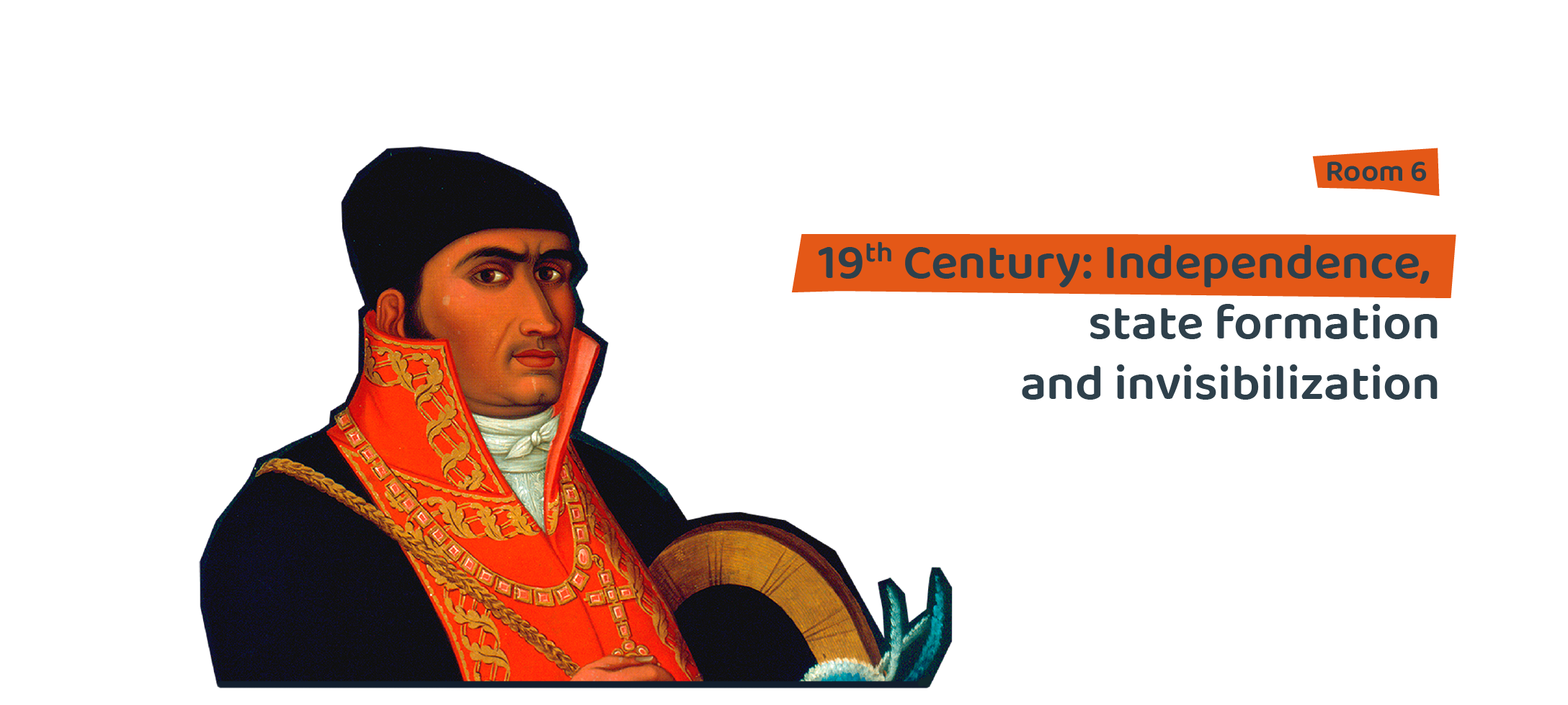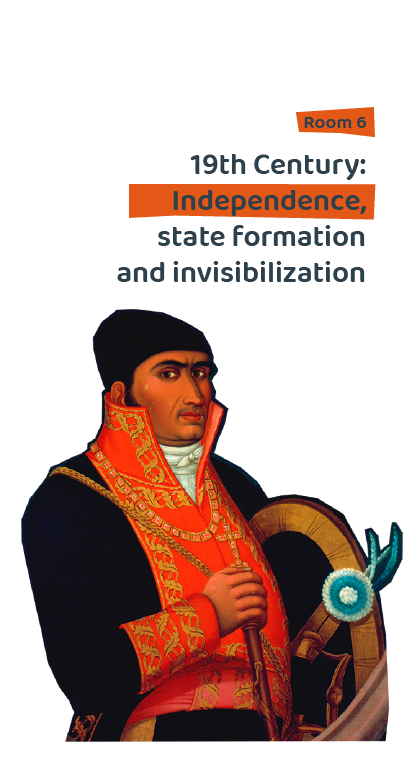



José María Morelos, independence leader of Mexico, he fought for the rights of all Mexicans and to abolish the caste and quality differences. Possibly Afrodescendant, although he was registered as Spanish in his baptism certificate.
The Haitian Revolution, the ideals of the early days of the French Revolution in the late 18th century and the debates in the Cortes of Cádiz propelled the notion that slavery was an archaic, unfair exploitation system. Despite that, in the early 19thcentury, slavery of Africans and Afrodescendants in the New Spain was no longer as profitable as in previous times, there were still haciendas, private homes, manufacturing plants and other enterprises using forced labor. "The Apache", captured under the guise of a “just war”, also were still facing this form of subjugation. The first proclamations of Miguel Hidalgo rigorously declared the abolition of slavery. The first one happened in the 19th of October 1810 in Valladolid, nowadays Morelia; it was a document which demanded the immediate liberation of enslaved people and threatened to kill the owners who disobeyed. Afterwards in December of that same year, the insurgent leader would proclaim the immediate demand to abolish slavery. José María Morelos, possibly an Afrodescendant, also wrote exhaustively on the topic in Feelings of the Nation, stressing the importance of eliminating castes and qualities and for the inhabitants of Mexico to be recognized as Americans. The proclamations were not fully regarded and it took almost 20 years for this form of exploitation and subjugation to be formally abolished.
Transcript of a fragment of the first proclamation of Miguel Hidalgo abolishing slavery, published in the city of Valladolid by Chief Magistrate Ansorena in October 19th 1810
Don José María de Ansorena, gentleman, master of the Real de Ronda, ordinary mayor and first ballot of this city and jurisdiction, Chief Magistrate of this province and Brigadier-General. In prompt compliance with the wise and merciful words of H.E., Mr. Captain general of the American Nation, Doctor Don Miguel Hidalgo y Costilla, to whom I wish to express my most sincere thanks for such unique benefits. I warn all slave owners that the moment notice should arrive of this supreme order to free the slaves and grant them the deed of Alahorria with the accustomed entries so that they can trade and hire, appear in court, give will and testament, codicils, and execute any action that free people can perform. Should slave owners decide not to enact the orders, they shall suffer capital punishment: the confiscation of all their assets. Under the same imposed order, they shall no longer buy or sell any slave whatsoever, nor the notaries, be them royal or local, shall extend deeds concerning such contracts under penalty of revoking their profession and confiscation of all their assets; the reason being neither humanity nor mercy would stand for such acts. Its also concordant to the merciful attitude of H.E. that payment of tributes for all kinds of castes be abolished, no matter the kind; so that no collector nor judge demands this payment, nor the wretched who used to pay them do so now. So it is the will of H.E. Mr. Captain General to benefit the American Nation as soon as possible.
Written in Valladolid, 19th of October 1810
José María de Ansorena (Signature)
Notarized to be published the 28th of October (Signature)
Commanded by H.H. José Geronimo Marocho (Signature)
Many Afrodescendants were part of the insurgent movement, particularly in the south of Mexico and especially in the regions of what is today the State of Guerrero. Some of them had been militiamen and knew about war strategies, others, like Vicente Guerrero, were mule drivers and had traveled across paths difficult to access. They knew the people and the communities along the roads of the Mixtec region and the adjoining lands in the coasts of Guerrero and Oaxaca. Vicente Guerrero was born in Tixtla, in the mountains of the state now named after him. He belonged to a family of Afrodescendant mule drivers and gunsmiths. He was the most popular leader of the insurgent movement after the dead of Morelos. He kept the fight going through guerrilla warfare during the hardest years of the struggle between 1815 and 1821. Later, Guerrero finally signed an agreement with Iturbide to consummate the independence. He was the second president of Mexico in 1829 and during his presidency once again the abolition of slavery was decreed. He had to quit the position because of inner political pressures and years later he was captured and executed in Cuilapan, Oaxaca.
The Mascogos are an Afromexican group whose ancestors arrived to national territory in mid-19th century. Their communities are located in El Nacimiento and in Múzquiz, Coahuila. At the end of the 17th century and in early 18th century, many slaves working in the rice and cotton plantations in the Anglo American territories of South Carolina, Georgia and Alabama, took refuge in Florida which was back then part of the Spanish Empire and was promising them their freedom. There they lived along runaway Indigenous people named Seminoles and that is why the Mascogos are considered to have originated from the exchange and cohabitation of these two groups. Seminole leaders started a relationship with the Mexican government who had consummated its independence and had abolished slavery. Together with the Kickapoos, Seminoles and Mascogos arrived to Mexico in 1850; they received lands and shelter in exchange to setting up defensive positions along the border. Mascogos are famous in their regions because of their ability as riders which they display in a parade celebrating how they earned their territory.
Starting the 19th century and in spite of the ideas concerning human rights in several parts of the world, racism as an ideology started to gain significant ground. Mestizaje or the cultural and biological exchange between different social groups became in Mexico the strategy to achieve national unity. When this ideology, created after 19thcentury Mexican liberalism, was made public, the historical evidence of the participation and contributions of Africans and Afrodescendants, their place in the demographics and their role in the establishment of the country were omitted. An example of this can be found at the end of the 18thentury, when Francisco Javier Clavijero first wrote on the history of Mexico. He chose only to magnify the importance of the Spanish and Indigenous populations in the creation of the Mexican identity and the Nation-State. Parallel to such practices, racism with particular characteristics for the region, developed in the territory. On the one hand, the historical and contemporary participation of Afrodescendants in Mexico was denied and silenced, on the other, the indigenous past was praised, undervaluing their current problems and contributions. Throughout the 19th and for most of the 20th century, the idea that there were superior and inferior “races” was promoted. Racism refers to attitudes, opinions, beliefs, prejudices or stereotypes that turn into social practices and behaviors (discrimination, persecution, segregation) or institutionally exclusive actions. All this is based on incorrect ideas that there are superior and inferior social groups. Said categories are “natural” and they are expressed through skin color, facial features or hair type and in cultural practices like eating habits, religious beliefs, clothing, dancing, music and family relationships. Through multiple recent studies done by geneticists, biologists, anthropologists, sociologists and other scholars on the subject, the concept of different races has been fully refuted; human beings constitute only one species. Physical features, skin and eye color, type of hair, among other characteristics, represent barely 0.01% of gene variation between individuals or population groups. Besides, said variations are not related with any particular attribute or capability like intelligence, performance in certain areas of knowledge or the development of specific cultural values. To summarize, human beings are practically the same as a species but we are diverse in social, cultural and artistic expressions.
